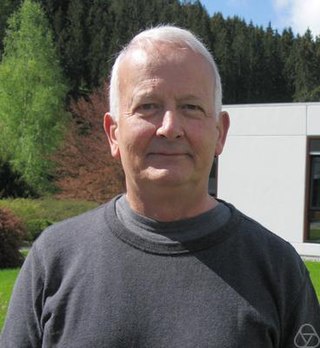In the mathematical field of geometric topology, a Heegaard splitting is a decomposition of a compact oriented 3-manifold that results from dividing it into two handlebodies.

In mathematics, a 3-manifold is a topological space that locally looks like a three-dimensional Euclidean space. A 3-manifold can be thought of as a possible shape of the universe. Just as a sphere looks like a plane to a small and close enough observer, all 3-manifolds look like our universe does to a small enough observer. This is made more precise in the definition below.

Poul Heegaard was a Danish mathematician active in the field of topology. His 1898 thesis introduced a concept now called the Heegaard splitting of a 3-manifold. Heegaard's ideas allowed him to make a careful critique of work of Henri Poincaré. Poincaré had overlooked the possibility of the appearance of torsion in the homology groups of a space.
Algorithmic topology, or computational topology, is a subfield of topology with an overlap with areas of computer science, in particular, computational geometry and computational complexity theory.
In mathematics, Floer homology is a tool for studying symplectic geometry and low-dimensional topology. Floer homology is a novel invariant that arises as an infinite-dimensional analogue of finite-dimensional Morse homology. Andreas Floer introduced the first version of Floer homology, now called symplectic Floer homology, in his proof of the Arnold conjecture in symplectic geometry. Floer also developed a closely related theory for Lagrangian submanifolds of a symplectic manifold. A third construction, also due to Floer, associates homology groups to closed three-dimensional manifolds using the Yang–Mills functional. These constructions and their descendants play a fundamental role in current investigations into the topology of symplectic and contact manifolds as well as (smooth) three- and four-dimensional manifolds.

Ciprian Manolescu is a Romanian-American mathematician, working in gauge theory, symplectic geometry, and low-dimensional topology. He is currently a professor of mathematics at Stanford University.

In mathematics, a normal surface is a surface inside a triangulated 3-manifold that intersects each tetrahedron in several components called normal disks. Each normal disk is either a triangle which cuts off a vertex of the tetrahedron, or a quadrilateral which separates pairs of vertices. In a given tetrahedron there cannot be two quadrilaterals separating different pairs of vertices, since such quadrilaterals would intersect in a line, causing the surface to be self-intersecting.

Clifford Henry Taubes is the William Petschek Professor of Mathematics at Harvard University and works in gauge field theory, differential geometry, and low-dimensional topology. His brother is the journalist Gary Taubes.

William "Bus" H. Jaco is an American mathematician who is known for his role in the Jaco–Shalen–Johannson decomposition theorem and efficient triangulations of 3-manifolds. He retired from Oklahoma State University in 2021 as Regents Professor Emeritus and appointed adjunct professor at Rice University in 2021.

John Robert Stallings Jr. was a mathematician known for his seminal contributions to geometric group theory and 3-manifold topology. Stallings was a Professor Emeritus in the Department of Mathematics at the University of California at Berkeley where he had been a faculty member since 1967. He published over 50 papers, predominantly in the areas of geometric group theory and the topology of 3-manifolds. Stallings' most important contributions include a proof, in a 1960 paper, of the Poincaré Conjecture in dimensions greater than six and a proof, in a 1971 paper, of the Stallings theorem about ends of groups.
Friedhelm Waldhausen is a German mathematician known for his work in algebraic topology. He made fundamental contributions in the fields of 3-manifolds and (algebraic) K-theory.
In mathematics, the tunnel number of a knot, as first defined by Bradd Clark, is a knot invariant, given by the minimal number of arcs that must be added to the knot so that the complement becomes a handlebody. The tunnel number can equally be defined for links. The boundary of a regular neighbourhood of the union of the link and its tunnels forms a Heegaard splitting of the link exterior.

Abigail A. Thompson is an American mathematician. She works as a professor of mathematics at the University of California, Davis, where she specializes in knot theory and low-dimensional topology.
Colin Rourke is a British mathematician who worked in PL topology, low-dimensional topology, differential topology, group theory, relativity and cosmology. He is an emeritus professor at the Mathematics Institute of the University of Warwick and a founding editor of the journals Geometry & Topology and Algebraic & Geometric Topology, published by Mathematical Sciences Publishers, where he is the vice chair of its board of directors.
Martin George Scharlemann is an American topologist who is a professor at the University of California, Santa Barbara. He obtained his Ph.D. from the University of California, Berkeley under the guidance of Robion Kirby in 1974.
In mathematics, the curve complex is a simplicial complex C(S) associated to a finite-type surface S, which encodes the combinatorics of simple closed curves on S. The curve complex turned out to be a fundamental tool in the study of the geometry of the Teichmüller space, of mapping class groups and of Kleinian groups. It was introduced by W.J.Harvey in 1978.

Jeffrey Farlowe Brock is an American mathematician, working in low-dimensional geometry and topology. He is known for his contributions to the understanding of hyperbolic 3-manifolds and the geometry of Teichmüller spaces.
Jennifer Carol Schultens is an American mathematician specializing in low-dimensional topology and knot theory. She is a professor of mathematics at the University of California, Davis.

Introduction to 3-Manifolds is a mathematics book on low-dimensional topology. It was written by Jennifer Schultens and published by the American Mathematical Society in 2014 as volume 151 of their book series Graduate Studies in Mathematics.

Henry Segerman is an Associate Professor of mathematics at Oklahoma State University in Stillwater, Oklahoma who does research in three-dimensional geometry and topology, especially three-manifolds, triangulations and hyperbolic geometry.











